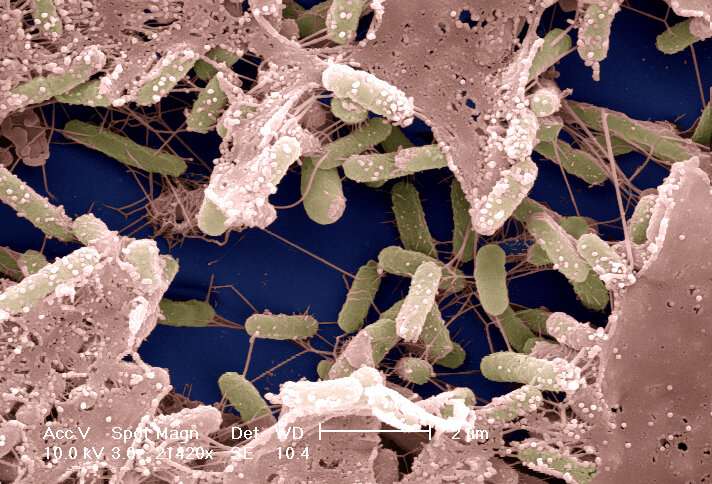Scientists from the Quadram Institute at the Norwich Research Park have made an important discovery into the workings of bacterial communities.
Using a newly developed method, they have discovered the genes used by bacteria to live within complex communities called biofilms. This could lead to new ways of stopping bacterial biofilms forming, helping prevent infections.
Biofilms are a normal mode of life for bacteria. Communities of microbes form biofilms by exuding a sticky slime to hold them together and also to adhere to surfaces. This helps protect the community from environmental stresses, like drying out or UV light, as well as the actions of disinfectants or antibiotics.
Biofilms are important as in certain settings, such as in hospitals or in food production, they can be a significant source of infections or contamination of hospital environments and foodstuffs. On the other hand, biofilms can also be beneficial, and we use bacterial biofilms to make products including some medicines like insulin.
Dr. Mark Webber from the Quadram Institute and University of East Anglai and his team used a genetic sequencing platform developed by Quadram researchers called TraDIS-Xpress. This can simultaneously analyze all of an organism’s genes to find those that are essential, as well as those which when turned on or off help the organism survive and grow under specific conditions.
The team used the model bacterium E. coli and identified which genes were important at each different stage of building the biofilm through time, at the beginning, middle and end. They then investigated how turning these genes on or off was beneficial or detrimental to the formation of these complex communities.
Some genes were important at all stages of the biofilm’s development, including those involved in regulating movement and adhesion. Others had important roles only at defined times in a biofilm. Some genes were beneficial for early biofilm formation but had a detrimental effect later as the biofilm matured, and five genes were identified that had never before been described to affect biofilm formation.
Understanding which genes are involved throughout the biofilm’s development will inform the development of anti-biofilm drugs to stop infections and the development of ‘biomarkers’ that alert doctors early on to the presence of a biofilm infection.
Mark Webber said “Understanding how bacteria make a biofilm at this level of genetic detail gives us the chance to use this information to predict how better to control biofilm formation. This could be to prevent biofilms forming where they may harm health, but also to encourage them in useful industrial applications.”
Lead author Emma Holden said “This work has lots of applications for preventing bacterial infection and contamination. The next step will be to use this same approach on lots of different bacterial species forming biofilms on a range of different surface materials, to see what’s the same and what’s different. This will inform the production of broad range and situation-specific anti-biofilm drugs.”
More information:
Emma R. Holden et al, Massively parallel transposon mutagenesis identifies temporally essential genes for biofilm formation in Escherichia coli, Microbial Genomics (2021). DOI: 10.1099/mgen.0.000673
Provided by
Quadram Institute
Citation:
Beating biofilms: New study identifies essential genes for bacterial survival (2021, November 17)



